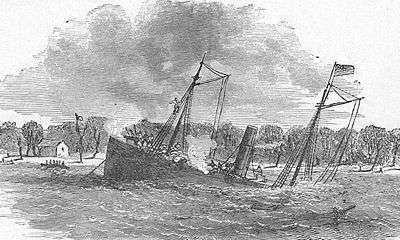USS Varuna (1861)
USS Varuna (1861) was a heavy (1,300 ton) steam-powered ship acquired by the Union Navy during the early days of the American Civil War. She was outfitted with powerful 8-inch guns and assigned, as a gunboat, to the Union blockade of the waterways of the Confederate States of America.
 USS Varuna | |
| History | |
|---|---|
| Builder: | Mallory Yard, Mystic, Connecticut |
| Laid down: | January or early February 1861 |
| Launched: | September 1861 |
| Acquired: | 31 December 1861 at New York City |
| Commissioned: | circa February 1862 |
| Out of service: | 24 April 1862 |
| Stricken: | 1862 (est.) |
| Fate: | sunk in action 24 April 1862 |
| General characteristics | |
| Displacement: | 1,300 tons |
| Length: | 218 ft (66 m) |
| Beam: | 34 ft 8 in (10.57 m) |
| Depth of hold: | 18 ft 3 in (5.56 m) |
| Propulsion: |
|
| Speed: | not known |
| Complement: | not known |
| Armament: |
|
Built in Connecticut
Varuna, the first U.S. Navy ship to bear the name, was originally intended for merchant service between New York City and New Orleans. She was laid down in late January or early February 1861 at the Mallory Yard, Mystic, Connecticut; launched there in the following September; and purchased by the Navy at New York City on 31 December 1861.
Civil War service
Joining the Union blockade
On 10 February 1862, she was ordered to remain in New York until Monitor was ready for action so that she might escort the new ironclad from New York to Hampton Roads, Virginia, to protect the wooden-hulled Union blockaders there from the Southern armored ram, CSS Virginia.
However, these orders were revoked later that same day; and Varuna was assigned to the newly established West Gulf Blockading Squadron. En route south late in February, Varuna put into Port Royal, South Carolina, for repairs, where the ship's commanding officer, Commander Charles S. Boggs, assumed temporary command of the harbor on 24 February during Flag Officer Samuel F. Du Pont's absence. The gunboat finally joined Rear Admiral David G. Farragut's West Gulf Blockading Squadron on 6 March.
Mississippi River operations
On 24 April 1862, Varuna was with the squadron during Farragut's daring nighttime dash past Confederate works guarding the Mississippi below New Orleans – Fort Jackson and Fort St. Philip.
Varuna sunk in action
At the height of the melee, Varuna was rammed twice by the steamer CSS Governor Moore and struck twice again immediately thereafter by the cotton-clad ram CSS Stonewall Jackson. After striking Varuna, CSN Lt. Beverly Kennon, in command of one of the Confederate warships, Governor Moore – found himself unable to depress his guns far enough to fire upon the Union vessel. So he shot through the bow of his own ship and used the resulting hole as a gun port.
Fatally damaged, Varuna backed off from the Confederate vessels and continued to subject them to a withering fire until rising water silenced her guns. Eight sailors of the Varuna received the Medal of Honor for their actions during the battle: Seaman Thomas Bourne, Landsman Amos Bradley, Captain of the Forecastle John Greene, Third Class Boy George Hollat, Seaman William Martin, Quartermaster John McGowan, Coxswain William McKnight, and Second Class Boy Oscar E. Peck.[1][2]


Varuna honored with a poem
Rear Admiral Farragut's stunning victory at and subsequent capture of New Orleans itself electrified the North. Varuna's part in the Union triumph was soon commemorated in George Henry Boker's poem, "The Varuna", which appeared in the Philadelphia Press on 12 May.
See also
- United States Navy
- List of United States Navy ships
- Bibliography of early American naval history
References
- "Civil War Medal of Honor Recipients (A–L)". Medal of Honor Citations. United States Army Center of Military History. 6 August 2009. Retrieved 14 October 2009.
- "Civil War Medal of Honor Recipients (M-Z)". Medal of Honor Citations. U.S. United States Army Center of Military History. 3 August 2009. Retrieved 14 October 2009.
This article incorporates text from the public domain Dictionary of American Naval Fighting Ships. The entry can be found here.